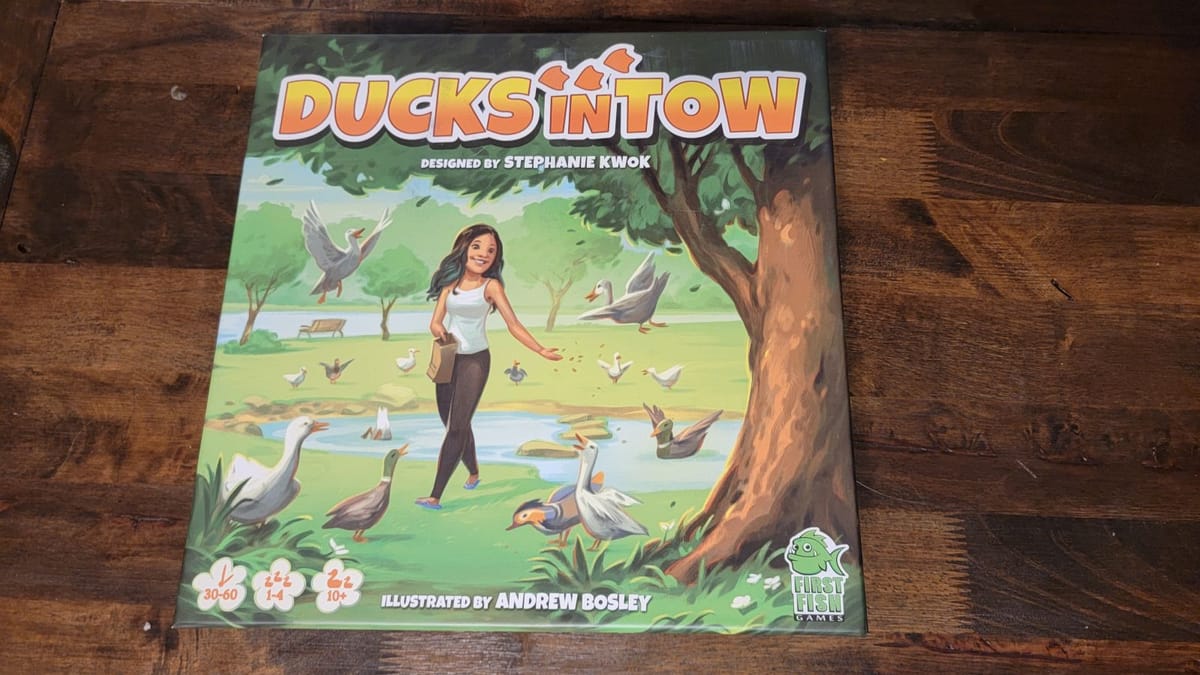
Admit it, we’ve all fought the urge to feed the ducks at the park (no matter what the park signs may tell you) while secretly hoping that the ducks will accept you as one of their own and begin following you around, right? Well, you’re in luck as Ducks in Tow allows you to do just that! In this delightful game, playable solo or with up to four players, you will roam around a park feeding and collecting ducks before dropping them off at scenic park locations. Featuring small but detailed wooden ducks and food pellets, along with high-quality cards and game board pieces, Ducks in Tow is surprisingly well-made, easy to understand, and quite fun, making for a great family game night.
Set up for Ducks in Tow depends completely on the number of players involved but consists of laying out hexagonal shapes in a predetermined pattern. The more players, the larger the board you will construct. A few of the pieces are set, while others are pulled and placed at random. The random pieces act as the drop off destinations and determine the location cards which will be used for that playthrough. Each location card lists a drop off location along with what ducks need to be following you for you to be able to make the drop off. Players will then be given four random location cards and the remaining location card deck will be placed in a central location, with four location cards laid out and visible to all. The location cards in your hand are to remain secret from other players.
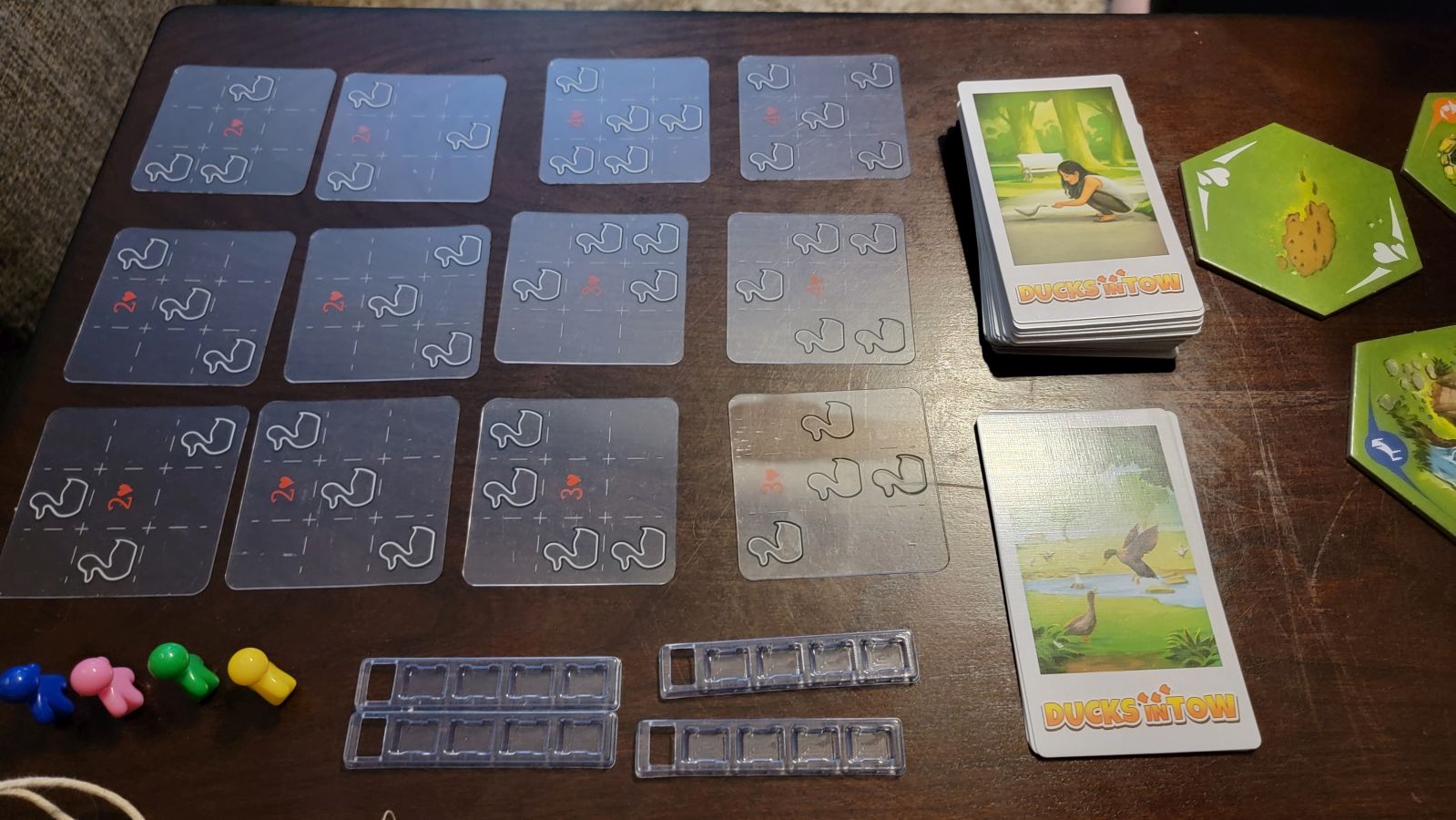
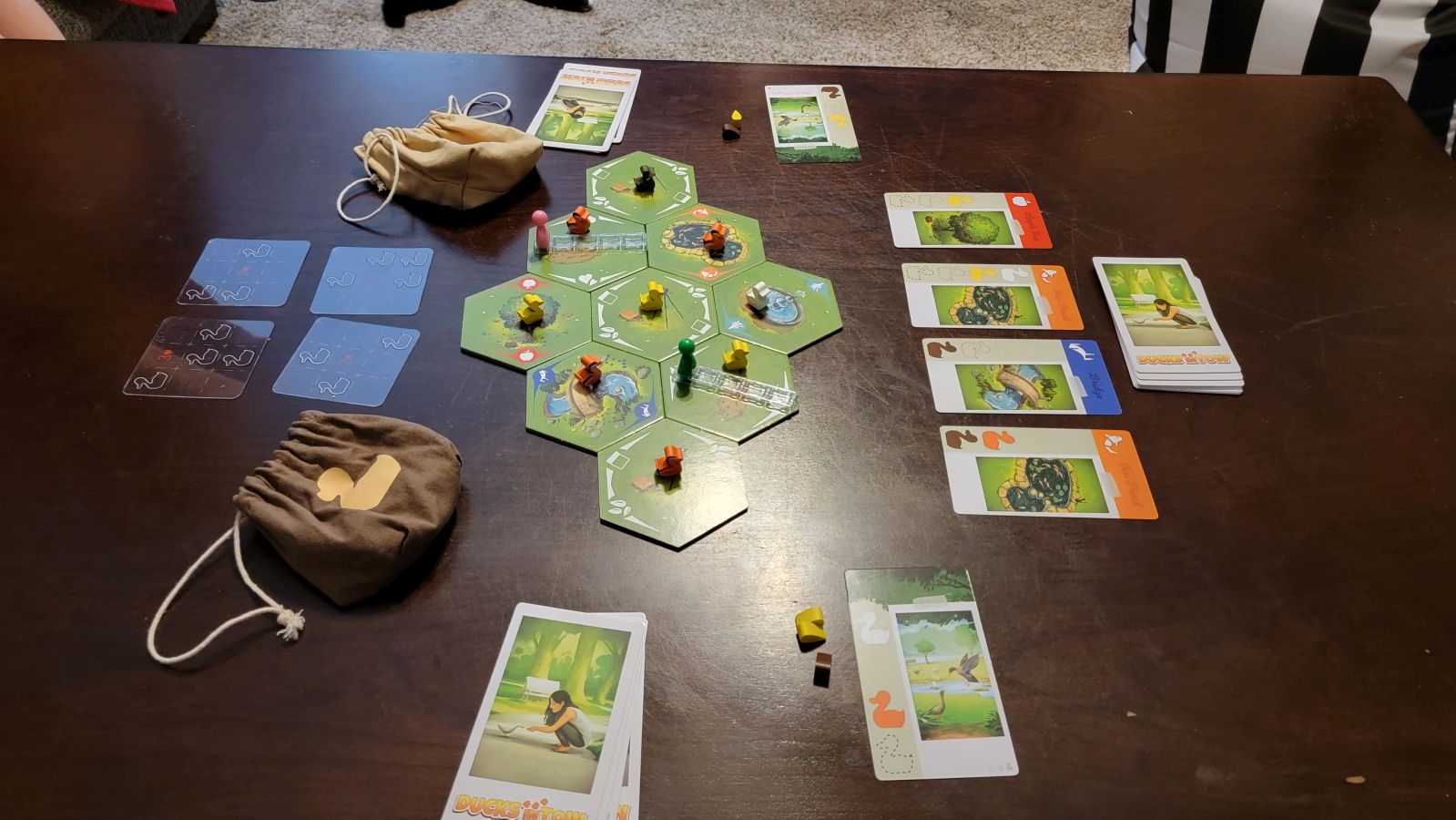
Two bags, one containing ducks and one containing food pellets, are then set up for play. The number of ducks available is based on player count, but there are four colors of ducks and four corresponding food pellet colors. At the beginning of the game ducks will be chosen at random and one duck will be placed on each hexagonal board game piece. Players then place their pawns in their designated starting positions. These pawns fit snugly at the front of a plastic row, which has additional spots to hold up to four ducks. Each player gets a starting card which features a duck formation which the player can build out from, and players will lay this card down in front of them. Finally, players will shuffle and pull out the designated number of formation cards, which can be later used to gain additional points.
Play begins with players looking at their location cards and determining the paths they need to take to make the drop offs required. Location cards showcase the section of the game board that you must move to along with how many and what color ducks you must take to that location to complete the drop off. During each turn, a player must take four actions, which consist of moving, feeding, dropping off, or completing a special tile action. Special tile actions include the gift shop and adoption (more on those later). Moving is as simple as it sounds, each move to a new piece of the game board counts as one action. Feeding also counts as one action, and to feed a duck you must provide it with a food pellet matching its color. After feeding a duck it will then join you and follow you around the board. To drop off you must collect all the ducks required to complete a location and move to that location on the board. Dropping off ducks, regardless of the amount in tow, counts as one action.
The special tile actions of adoption and gift shop can only be completed when you are standing on a game board piece with the corresponding icons. Choosing to spend on action on the gift shop allows you to gain 2 food pellets of your choice from the food pellet bag or draw two new location cards. A player cannot hold more than four food pellets or location cards at once. Choosing to use the adoption icon allows you to remove two ducks from your tow and use one of the two ducks to help flesh out a pattern on your completed location cards.
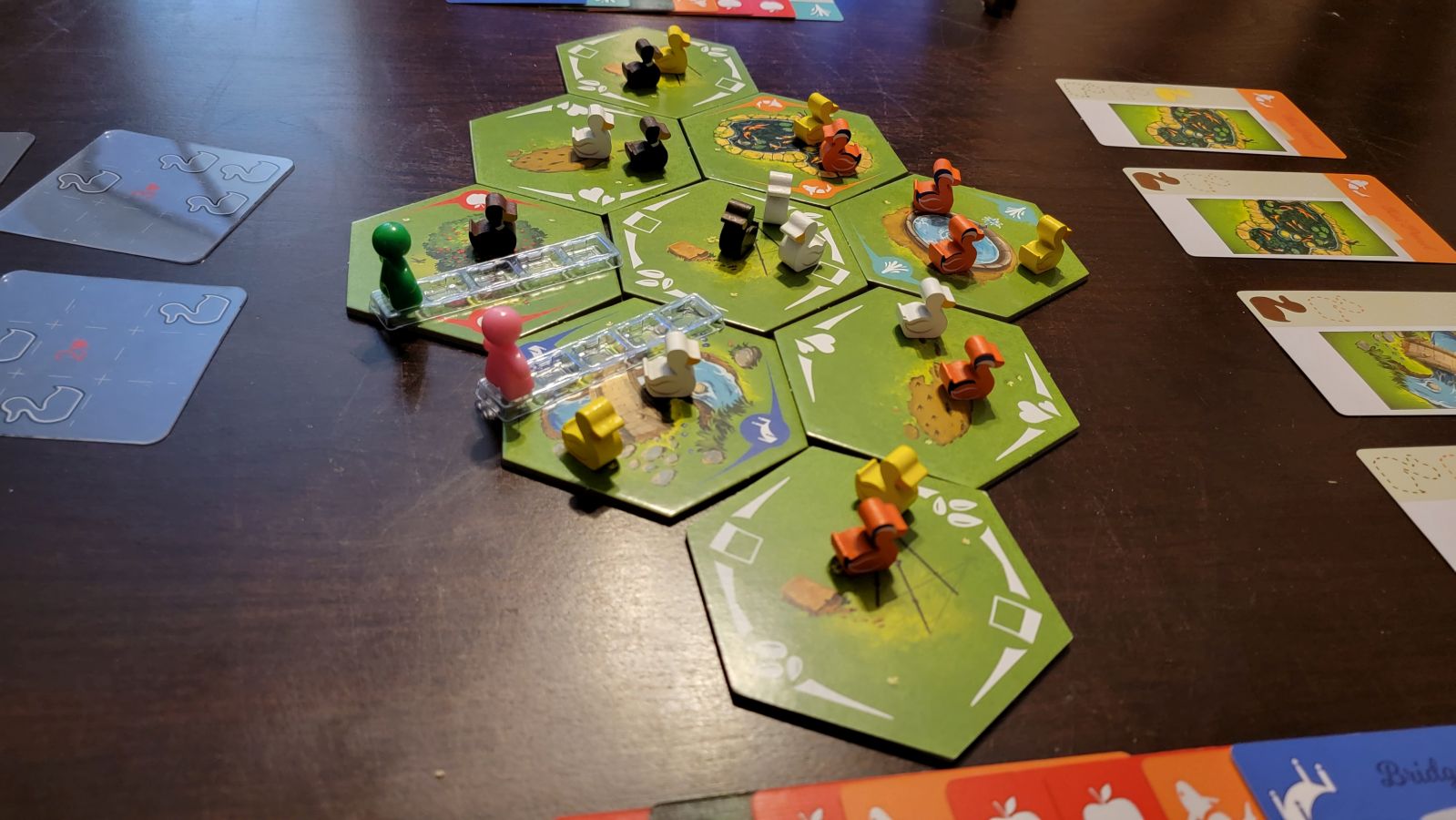
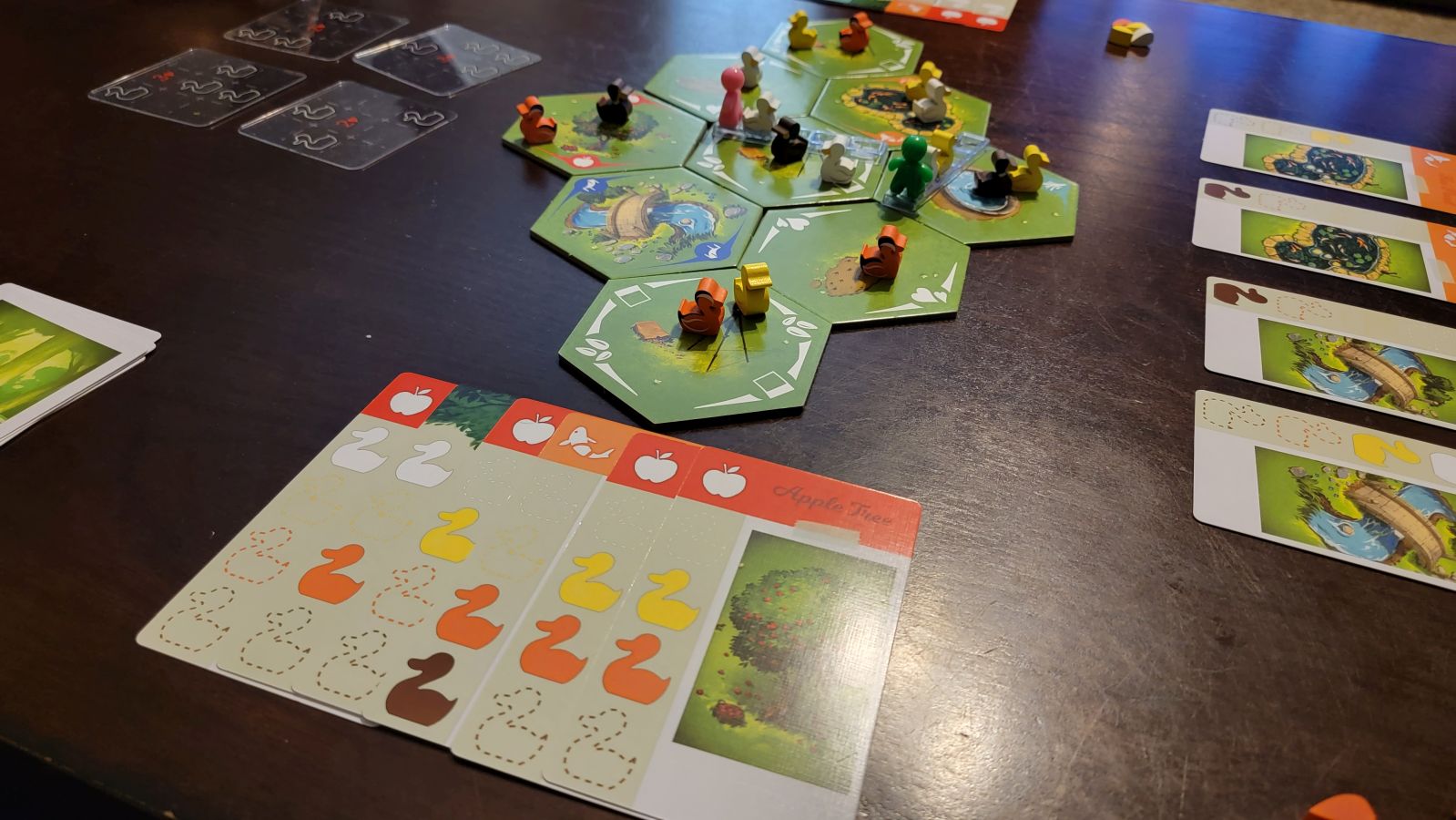
When you complete a drop off, you then place that location card to either the left or right side of your starting card. As previously stated, each card shows which ducks were required to complete a drop off. These ducks are aligned on the left of the card and are color coded. When you complete a drop off, you can match the colors up with other completed drop off cards and your starting card to create a line of ducks. This is essential to gaining end of game points. Each line of ducks is worth one point per duck, but ducks that are solo are worth no points. The only other way to gain points is to use one of the previously mentioned formation cards, which have specific duck patterns on them and can be overlaid on your cards. If you match a formation, you gain the points shown on that formation card.
After a player completes their turn, three actions happen. First, if they had completed a drop off, all the ducks they dropped off, plus one additional duck pulled at random from the duck bag, are then placed back on the board. Then food pellets and location cards are drawn until the player is back to four of each. Play then proceeds to the next player. The game ends when a player reaches eight completed location cards, after which points are tallied.
While a first playthrough may take a while to complete as players learn the rules and get comfortable with how to score points, subsequent playthroughs tend to fly by. At first glance Ducks in Tow appears disarmingly simple, but further time with the game teaches players that just because they have a location card they can complete, it may be in their best interest to ignore it in favor of completing drop offs which will match formation cards or create longer streaks of a specific duck color.
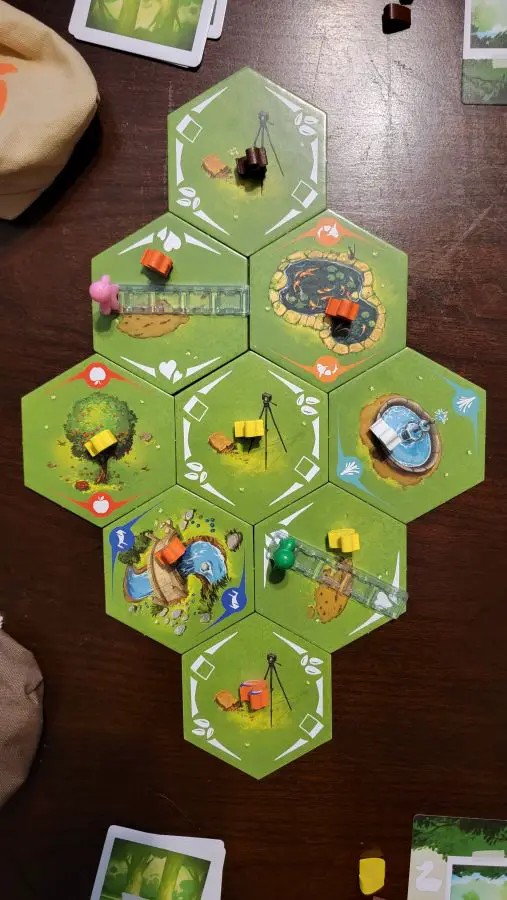
The only gripe I have is that the game ends when one player completes eight location cards, but this may not be seen as a negative for some players. While I understand that some type of end condition needs to be set, this rule forces other players to base their playstyle around the player moving fastest – even if that player is only attempting to complete drop offs rather than earn points. I’d prefer the game ending when all location cards having been completed, thereby allowing players more time to create streaks and giving a chance for other players to strategize even if one player isn’t concerned with points. Still, it’s a minor gripe and may not even become an issue in most playthroughs.
Whether you get competitive and play for the most points or prefer to rush through and be the first to complete the most drop offs, Ducks in Tow is fun for all playstyles. Ducks in Tow’s overall quality is impressive, from the detailed artwork on the game case and cards, to the thick game board pieces and wonderfully detailed wooden ducks. While Ducks in Tow could have easily gone with cheap plastic ducks and food pellets with no detriment to the game, I appreciate the work put into the presentation along with the surprising amount of strategy and thought put into the gameplay, despite the simple premise.
Ducks in Tow
Excellent
Ducks in Tow is charming, well made, and fun solo or with up to four players. A simple concept, feeding ducks and dropping them off at random park locations, packs a surprising amount of depth once you factor in color streaks, formation cards, the gift shop, and adoption options, leading to the game remaining fresh throughout multiple playthroughs. Easy to learn and set up, Ducks in Tow is perfect for a family game night.
Pros
- Unique concept
- Has enough depth to engage players for multiple sessions
- Well-made components and game board
Cons
- Endgame trigger feels abrupt and unsatisfying
